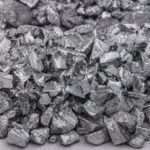TITANIUM
Abundance and Extraction

Titanium is a transition metal with the atomic number 22 and Ti symbol. As of 2023, the leading producers of titanium are China, Mozambique, and South Africa*.
Titanium is extracted from minerals or mineral species (anatase and rutile) and is composed of titanium dioxide (TiO2). Its mining is expensive, and current technologies do not allow for the exploitation of all terrestrial resources, which are substantial, as titanium is the ninth most abundant element and the fifth most abundant metal on Earth.
Obtaining pure titanium from titanium dioxide requires complex chemical processes.
Pure Titanium, Titanium Alloys, and Classification
After extraction, pure titanium can be melted or used to produce various alloys, of which 34 are known. Pure titanium and its alloys are classified by their grade, corresponding to either pure titanium or a specific blend. Grades 1, 2, 3, and 4 refer to pure titanium, which differ based on the chosen smelting method and the number of successive remelts. The mechanical properties of pure titanium can therefore vary significantly. Grades 5 to 38 show different titanium alloys.
Grade 5, representing more than 50% of titanium production, is the most widely used in horology. Adding aluminium and vanadium to its composition (TiAl6V4) further enhances its hardness, impact and corrosion resistance.
Exceptional Characteristics
Titanium boasts numerous mechanical properties, making it a material of interest to various industries, including aerospace, aviation, automotive, medtech, and, of course, horology. Titanium is lightweight yet mechanically strong. It is non-magnetic, biocompatible, and highly resistant to corrosion. Titanium’s properties remain stable at temperatures up to 600°C and in cryogenic conditions (-150 to -273°C). It is highly oxidizable, which contributes to its corrosion resistance. When exposed to air or water, a thin layer (less than a micrometre) composed mainly of titanium dioxide (TiO2) forms on the surface, effectively protecting the metal from corrosion.
Titanium is a poor conductor of electricity, making it unsuitable for manufacturing methods like electroerosion or galvanic treatments. However, it provides an excellent substrate for vapour phase deposition methods (CVD, PVD).
Additionally, titanium is a poor thermal conductor. While this characteristic is generally desirable, it complicates the machining process. During machining, the heat generated at the contact point between the tool and the titanium piece does not dissipate evenly and concentrates on the tool, causing it to overheat and wear out more quickly. Furthermore, titanium tends to ignite under high pressure or at temperatures above 300°C, which poses a significant risk.
Finally, titanium is well-suited for new additive manufacturing technologies such as selective laser melting.
Titanium was discovered and identified by British mineralogist William Gregor in 1794. However, it wasn’t until 1910 that New Zealander Matthew Albert Hunter developed a process to produce pure titanium (99%). In 1939, a scientist from Luxembourg, Wilhelm Kroll, perfected Hunter’s process, leading to the industrialization of titanium production.
Titanium first appeared in the aerospace and aviation industries in the 1950s. Due to its remarkable properties and decreasing production costs, titanium quickly attracted other industries, such as medtech, automotive, and by the late 1960s, horology.
Initially, titanium was used for watch cases and bracelets. Today, it can also be found in movement components, such as tourbillon cages.
Titanium is valued in the production of watch cases and bracelets for its lightness and mechanical and corrosion resistance. It is often the preferred metal for sports or military watch cases.
Today, titanium is highly prized for the quality and intensity with which it transmits sound in chiming watches. Additionally, titanium movement components, such as tourbillon cage structures, are occasionally found. They are 60% lighter than steel structures and non-magnetic.
